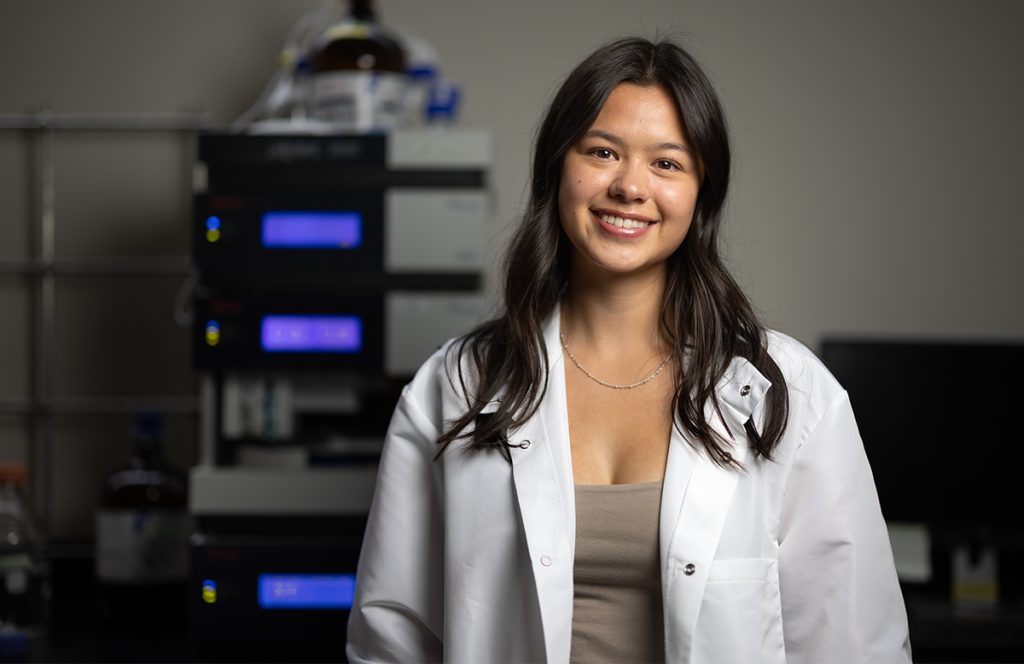
Kate Sun seeks to promote women’s health through holistic approaches that incorporate nutrition.
By Nicole Miller MS’06
Kate Sun BSx’26 has long been interested in matters of the mind, and she has a sense of purpose to go with it. As far back as her junior year in high school, she knew she wanted to study psychology, with the intent of becoming a therapist in the mental health field.
But Sun is also in tune with her body, and she’s willing to listen to what it tells her. While growing up in Denver, Colorado, she was a happy, well-adjusted youth — but she struggled with skin issues, such as rashes, allergies, and eczema.
“At one point, I pretty drastically changed my diet. Within two months, my eczema was gone, and it never came back,” Sun says. “That was the first time I thought about nutrition as a whole, and I thought it was so interesting. I started learning more about functional nutrition, how professionals use nutrition to support athletes but also to treat certain disorders.”
Sun, who is majoring in nutritional sciences and psychology, chose UW–Madison for the university’s strength in these two academic programs as well as its reputation for undergraduate research opportunities. By her sophomore year, Sun had connected with food science professor Brad Bolling BS’02, PhD’07, whose lab focuses on bioactive food components and their health benefits.
“At that point, I was really interested in the gut microbiome, dietary bioactives, and food as medicine,” Sun says. “I reached out to Brad, and we set up a meeting where he told me about this really cool project in his lab exploring something called cranberry PLP.”
Cranberries are chock full of dietary bioactives called polyphenols, compounds that have antioxidant and anti-inflammatory properties. Bolling had discovered a way to isolate and concentrate the polyphenols from cranberry juice, creating an end-product called polyphenol-lecithin precipitate, or PLP.
What Are Bioactives?
Bioactive compounds, which are naturally occurring chemicals commonly derived from plants, activate biological effects in the body that typically promote good health. Compounds called polyphenols, for example, serve as antioxidants — they help neutralize unstable, damage-causing molecules (free radicals) in the body.
Working closely with graduate student Klay Liu and researcher Andrea Noll MS’20, Sun began exploring whether cranberry PLP could be used to support oral health. The PLP delivery method in this case was chewing gum. Regular polyphenols, when added to gum, get chewed out and swallowed quickly. Not so with PLP.
“With PLP, the release of the polyphenols took place much more slowly and steadily over time,” Sun says. “So, when people chew this gum, the polyphenols stay in their mouths for longer, and they could possibly help with things like tooth decay, periodontal disease, and gum inflammation.”
Sun is now contributing to her third project in Bolling’s lab, and she has enjoyed the variety of experiences. Her second project, focused on the chemistry of two polyphenols, was supported by the UW Food Research Institute’s Summer Undergraduate Research Program in Food Safety. Through her current project, Sun is enrolling participants in a dietary study and helping them complete food tracking diaries. She’s also involved in writing up the team’s chewing gum research findings for publication in a scientific journal.
“Kate has been a wonderful contributor to our research group,” Bolling says. “She brings enthusiasm and a desire to connect research with practical applications, and she is committed to improving health.”
After graduation, Sun plans to continue her education. She may become a registered dietitian or pursue a certificate in functional nutrition or acupuncture. Whatever her next steps, her goal is to work in women’s health.
“Society puts us under a lot of stress, and that stress manifests in different ways for different people,” Sun says. “I love the idea of being able to work one-on-one with women to develop holistic approaches — including nutritional options — that can help mitigate the impact that stress has on the body and promote optimal wellness.”
This article was posted in https://grow.cals.wisc.edu/priority-themes/health-and-wellness/a-food-fight-with-stress
